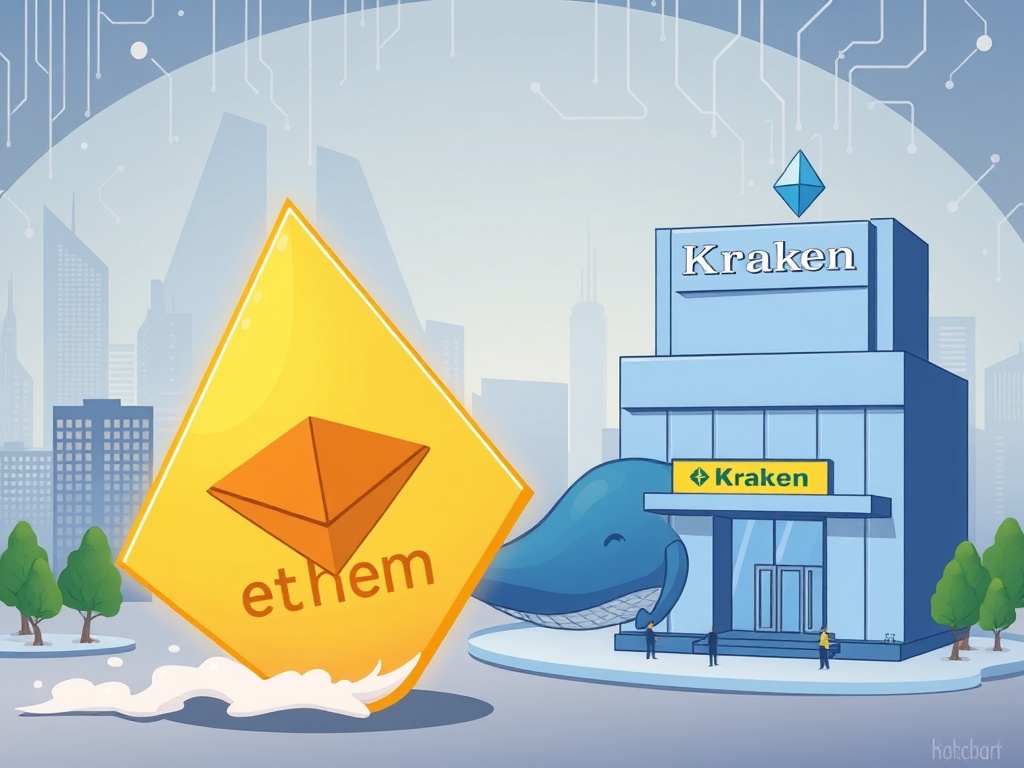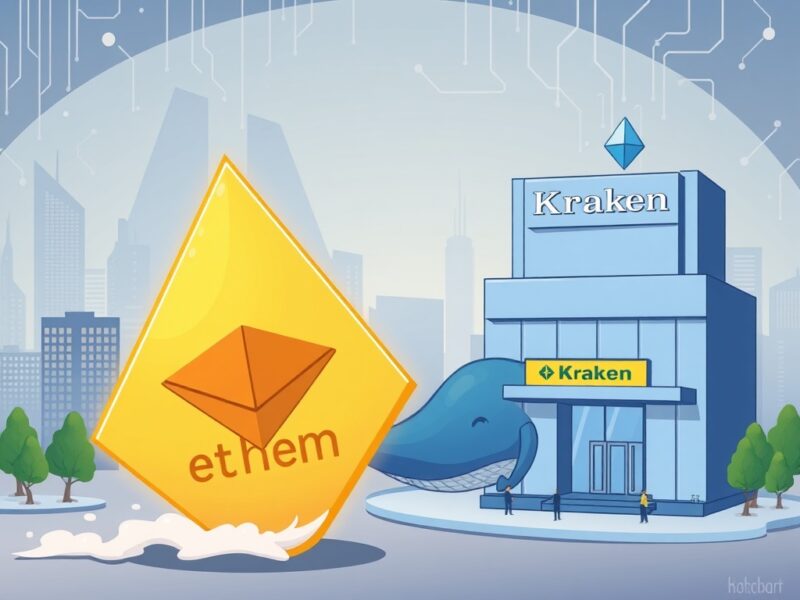BitcoinWorld

Gigantic ETH Transfer: Unpacking a Mysterious $236 Million Move to Kraken
The cryptocurrency world is no stranger to dramatic movements, but some transactions truly capture the attention of the entire market. Recently, the digital realm buzzed with news of a colossal ETH transfer – a staggering 62,215 Ethereum, valued at approximately $236 million, moved from an unknown wallet straight into the Kraken exchange. This isn’t just a large sum; it’s a financial earthquake that sends ripples across the blockchain, prompting investors, analysts, and enthusiasts alike to ask: what exactly is going on?
What Just Happened? The Gigantic ETH Transfer Explained
The alert came from Whale Alert, a well-known blockchain tracker that monitors significant cryptocurrency transactions. Their report highlighted a single, massive ETH transfer of 62,215 ETH, making its way from a wallet with no prior public association to Kraken, one of the world’s leading cryptocurrency exchanges. To put this into perspective, $236 million is a substantial sum, even in the high-stakes world of digital assets. Such a large movement of funds can signal various intentions, from a simple portfolio rebalancing to a strategic market maneuver. But what does it mean when the source remains anonymous?
Understanding the nature of such a transaction requires a look at a few key aspects:
- Scale: The sheer volume of 62,215 ETH is enough to influence market sentiment, especially if it’s perceived as a precursor to selling.
- Destination: Kraken is a reputable, regulated exchange. Transfers to exchanges often suggest an intent to sell, trade, or convert assets.
- Source: The “unknown wallet” aspect adds a layer of mystery. Is it an early investor, an institution, or a new player making a grand entrance?
This particular ETH transfer isn’t just a number; it’s a story unfolding on the blockchain, and every crypto enthusiast is trying to read between the lines.
Who Are These “Whales” and Why Do They Orchestrate Such Large ETH Transfers?
In the crypto lexicon, “whales” are individuals or entities holding vast amounts of a particular cryptocurrency, enough to potentially influence its market price. Their movements are closely watched because their actions can trigger significant volatility. When a whale executes a large ETH transfer, especially to an exchange, the immediate assumption is often that they intend to sell, which could increase supply and potentially drive down prices. However, the reality is often more nuanced.
Whales engage in large transfers for several reasons:
- Selling or Taking Profit: This is the most common speculation. After holding assets for a period, a whale might decide to realize gains, especially during periods of high price appreciation.
- Market Making or Liquidity Provision: Some whales are sophisticated traders who move funds to exchanges to provide liquidity, engage in arbitrage, or participate in complex trading strategies.
- Diversification: A whale might be moving ETH to an exchange to convert it into other cryptocurrencies or stablecoins, diversifying their portfolio.
- Custodial Services: The transfer might be from an institutional custodian moving funds on behalf of a client, or a large fund rebalancing its holdings.
- Security Concerns: In rare cases, a whale might move funds to an exchange for enhanced security, although self-custody is often preferred for large holdings.
The anonymity of the “unknown wallet” makes it impossible to pinpoint the exact motive behind this particular ETH transfer, fueling speculation and keeping the market on edge.
Kraken’s Role: A Trusted Destination for Massive ETH Transfers?
Kraken is one of the oldest and most respected cryptocurrency exchanges globally, known for its strong security measures, regulatory compliance, and wide range of trading pairs. The choice of Kraken as the destination for such a massive ETH transfer is significant. It suggests a level of trust in the exchange’s ability to handle large volumes and secure assets.
When an exchange receives such a substantial deposit, it typically means one of two things for the exchange itself:
- Increased Liquidity: More ETH on the exchange means more supply available for trading, which can improve liquidity for other traders.
- Potential for Increased Trading Volume: If the whale intends to trade, it will generate significant trading volume, which benefits the exchange through fees.
Kraken, like other major exchanges, employs robust security protocols, including cold storage for the majority of its assets, multi-factor authentication, and regular security audits. This makes it a preferred choice for large players looking to move and manage significant crypto holdings securely.
Market Impact: Will This ETH Transfer Shake Things Up for Ethereum?
The immediate question on everyone’s mind after a major ETH transfer is: what will be the market impact? While a $236 million deposit is substantial, Ethereum’s daily trading volume often runs into billions of dollars. Therefore, a single transaction, even of this magnitude, doesn’t automatically guarantee a price crash or surge.
However, the psychological impact can be significant. News of large whale movements can trigger a “fear of missing out” (FOMO) if perceived as bullish, or “fear, uncertainty, and doubt” (FUD) if perceived as bearish. If the whale starts selling their ETH, it could put downward pressure on the price. Conversely, if they are simply preparing to use it for decentralized finance (DeFi) activities or staking, the impact might be minimal or even positive in the long run.
Key factors influencing the market impact include:
1. Timing: The market’s overall sentiment and volatility at the time of the transfer play a crucial role. In a bull market, such a transfer might be absorbed easily; in a bear market, it could exacerbate declines.
2. Subsequent Actions: The most critical factor is what the whale does next. If the ETH sits idle, the impact is negligible. If it’s gradually sold off, the market can absorb it. A sudden, large sell-off, however, could cause a temporary dip.
3. Market Depth: Ethereum’s market depth on Kraken and other exchanges is considerable. This means there are many buy and sell orders at various price points, which can absorb large trades without extreme price swings.
Investors should monitor not just the transfer, but the subsequent trading activity from the receiving wallet on Kraken. Tools like on-chain analytics can provide insights into these movements.
Security and Anonymity: The Double-Edged Sword of Large ETH Transfers
The blockchain, by its nature, offers a degree of pseudonymity rather than complete anonymity. While the wallet address itself doesn’t reveal the owner’s identity, patterns of transactions and links to known entities can sometimes unmask “unknown” wallets. The ETH transfer in question highlights this duality: the transaction is publicly verifiable, yet the identity of the sender remains elusive.
From a security perspective, moving such a large sum carries inherent risks. While Kraken is secure, any transfer involves potential vulnerabilities, such as incorrect addresses, phishing attempts, or network congestion. However, given the professionalism often associated with whales, it’s highly probable that this transfer was executed with meticulous care.
The anonymity aspect also raises questions about regulatory oversight and anti-money laundering (AML) efforts. While exchanges like Kraken are regulated and perform Know Your Customer (KYC) checks on their users, the source of funds from an unknown wallet can still present challenges for tracking the ultimate beneficial owner. This ongoing tension between privacy and transparency is a core debate within the crypto space.
What Does This Mean for the Average ETH Holder and Investor?
For the everyday Ethereum holder, a massive ETH transfer like this might seem intimidating or confusing. However, it’s crucial to understand that while whale movements can cause short-term volatility, they don’t necessarily dictate the long-term trajectory of a robust asset like Ethereum.
Here are some actionable insights for investors:
- Stay Informed, Don’t Panic: News of large transfers can trigger emotional responses. Instead, focus on understanding the context and potential implications.
- Monitor On-Chain Data (But Don’t Overreact): Tools like Whale Alert are useful for tracking large movements. However, interpret data cautiously; a transfer to an exchange doesn’t always mean an immediate sell-off.
- Focus on Fundamentals: Ethereum’s value is driven by its ecosystem, development, adoption, and network upgrades (like the upcoming Dencun upgrade or future scaling solutions). These long-term fundamentals are often more impactful than short-term whale activity.
- Diversify and Manage Risk: Never put all your eggs in one basket. Diversify your portfolio and only invest what you can afford to lose.
- Consider Dollar-Cost Averaging (DCA): DCA can help mitigate the impact of short-term price swings by spreading your investments over time.
This event serves as a reminder that the crypto market is dynamic and influenced by a multitude of factors, not just individual large transactions.
Navigating the Crypto Seas: Tips for Astute Investors
The cryptocurrency market is an exciting, yet often unpredictable, environment. Large ETH transfers are just one of many data points that astute investors consider. To navigate these waters successfully, a strategic approach is essential.
Consider these tips:
- Conduct Thorough Research: Before investing in any cryptocurrency, understand its technology, use cases, team, and market position. Don’t rely solely on social media hype or news snippets.
- Understand Market Cycles: Crypto markets often move in cycles. Recognizing these patterns can help in making informed decisions about when to buy or sell.
- Secure Your Assets: Use hardware wallets for large holdings, enable multi-factor authentication on exchanges, and be wary of phishing scams.
- Set Clear Investment Goals: Define your risk tolerance, investment horizon, and profit targets. Stick to your plan, even when the market gets volatile.
- Learn from Market Events: Each major transaction or market event provides valuable lessons. Analyze why things happened and how they affected prices and sentiment.
By adopting a disciplined and informed approach, investors can better position themselves to thrive amidst the ebb and flow of the crypto market.
The Future of Large ETH Transfers: What’s Next?
As the cryptocurrency market matures, the nature of large ETH transfers is also evolving. We are seeing increasing participation from institutional investors, who often move much larger sums than individual whales. These institutions might use over-the-counter (OTC) desks for large trades to minimize market impact, or they might leverage sophisticated custodial solutions.
Furthermore, the growth of decentralized finance (DeFi) means that large amounts of ETH are increasingly being locked into smart contracts for lending, borrowing, staking, or liquidity provision, rather than solely being transferred to centralized exchanges for trading. This shift could change how whale movements are perceived and their direct impact on exchange-based liquidity.
The continuous development of Ethereum 2.0 (now known as the Consensus Layer and Execution Layer) and its transition to Proof-of-Stake also influences how ETH is held and moved. Staking pools, for instance, consolidate large amounts of ETH, and their movements could become a new focus for on-chain analysis.
Conclusion: The Enduring Mystery of the Massive ETH Transfer
The recent 62,215 ETH transfer to Kraken serves as a potent reminder of the dynamic and often opaque nature of the cryptocurrency market. While the immediate intentions of the “unknown wallet” remain shrouded in mystery, such significant movements invariably spark intense speculation and highlight the interconnectedness of market participants. Whether this colossal transfer presages a major market shift, a strategic rebalancing, or simply a whale preparing for new ventures, its impact reverberates across the ecosystem.
For investors, this event underscores the importance of vigilance, critical analysis, and a commitment to understanding the underlying forces at play. While whale movements can create ripples, a solid understanding of market fundamentals, robust security practices, and a disciplined investment strategy remain the strongest anchors in the volatile seas of cryptocurrency. Keep your eyes on the blockchain, but keep your head clear, for the story of this massive Ethereum transfer is likely just beginning to unfold.
Frequently Asked Questions (FAQs)
Q1: What is an “unknown wallet” in cryptocurrency?
A1: An “unknown wallet” refers to a cryptocurrency address whose owner’s identity has not been publicly disclosed or linked to any known entity. While the transaction itself is transparent on the blockchain, the individual or organization behind the wallet remains anonymous.
Q2: Why do large ETH transfers to exchanges cause market speculation?
A2: Large transfers of cryptocurrencies like ETH to exchanges often lead to speculation because it’s typically done with the intention to sell, trade, or convert the assets. A significant increase in supply on an exchange could potentially lead to downward price pressure if the assets are sold quickly.
Q3: Is Kraken a secure exchange for large cryptocurrency holdings?
A3: Yes, Kraken is considered one of the most secure and reputable cryptocurrency exchanges globally. It employs industry-leading security measures, including extensive cold storage for funds, robust encryption, and regular security audits, making it a trusted platform for large holdings.
Q4: How can I track large cryptocurrency movements like this ETH transfer?
A4: Services like Whale Alert specialize in tracking significant cryptocurrency transactions across various blockchains. On-chain analytics platforms also provide tools and data to monitor large wallet movements and exchange flows.
Q5: Does a single large ETH transfer always crash the market?
A5: Not necessarily. While a large transfer can cause short-term volatility and speculation, the overall market impact depends on several factors, including Ethereum’s daily trading volume, the market depth of exchanges, and whether the transferred ETH is actually sold or simply moved for other purposes (e.g., staking, DeFi).
Did this deep dive into the massive ETH transfer spark your interest? Share this article with your friends, fellow investors, and anyone curious about the intriguing world of crypto whales and market dynamics! Your insights and discussions help us all navigate this exciting space.
To learn more about the latest Ethereum trends, explore our article on key developments shaping Ethereum price action.
This post Gigantic ETH Transfer: Unpacking a Mysterious $236 Million Move to Kraken first appeared on BitcoinWorld and is written by Editorial Team





